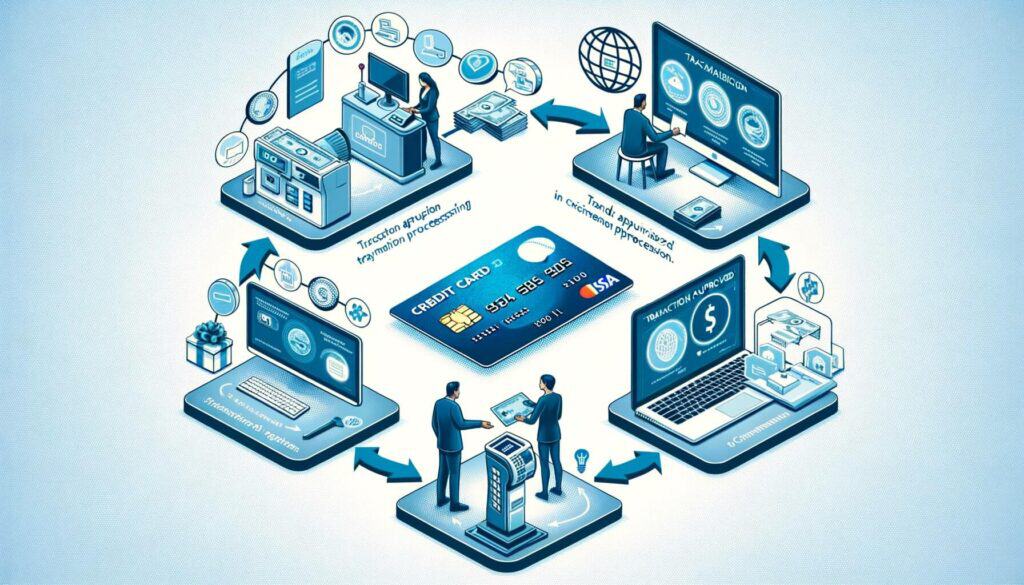
By Mollie Mills January 27, 2025
Credit card transaction processing is a crucial aspect of modern commerce, enabling businesses to accept payments from customers using credit cards. This process involves several stages and requires the involvement of payment processors, who facilitate the secure transfer of funds between the customer’s credit card account and the merchant’s bank account. Understanding how credit card transaction processing works is essential for businesses and consumers alike, as it ensures smooth and secure financial transactions.
In this comprehensive guide, we will delve into the intricacies of credit card transaction processing, exploring the role of payment processors, the four stages of processing, and the step-by-step processes involved in authorization, batch processing and clearing, and settlement and funding. We will also discuss different types of credit card transactions, security measures, and common challenges faced in this domain.
Understanding the Role of Payment Processors

Payment processors play a vital role in credit card transaction processing. These entities act as intermediaries between the merchant and the customer’s credit card issuer, facilitating the transfer of funds and ensuring the security of the transaction. Payment processors are responsible for verifying the customer’s credit card details, authorizing the transaction, and settling the funds with the merchant.
One of the key functions of payment processors is to ensure the security of credit card transactions. They employ various security measures, such as encryption and tokenization, to protect sensitive customer information and prevent fraud. Payment processors also provide merchants with tools and technologies to streamline the payment process, including payment gateways and point-of-sale systems.
The Four Stages of Credit Card Transaction Processing

Credit card transaction processing involves four distinct stages: authorization, batch processing and clearing, settlement, and funding. Each stage plays a crucial role in ensuring the smooth and secure transfer of funds between the customer and the merchant. Let’s explore each stage in detail.
1. Authorization: The first stage of credit card transaction processing is authorization. When a customer makes a purchase using a credit card, the merchant sends a request to the payment processor to verify the customer’s credit card details and ensure that they have sufficient funds to complete the transaction. The payment processor communicates with the customer’s credit card issuer to obtain authorization for the transaction. If the authorization is successful, the payment processor sends an approval code to the merchant, allowing them to proceed with the sale.
2. Batch Processing and Clearing: Once the authorization is obtained, the merchant collects a batch of authorized transactions throughout the day. At the end of the day, the merchant sends this batch of transactions to the payment processor for clearing. During the clearing process, the payment processor verifies the authenticity of each transaction and reconciles them with the customer’s credit card issuer. This ensures that the funds are available and that the transactions are legitimate. Once the clearing process is complete, the payment processor sends the transactions to the appropriate credit card issuers for settlement.
3. Settlement: The settlement stage involves the transfer of funds from the customer’s credit card issuer to the merchant’s bank account. After the payment processor sends the authorized transactions to the credit card issuers, the issuers transfer the funds to the payment processor. The payment processor then settles the funds with the merchant, deducting any applicable fees or charges. This process typically takes a few business days, depending on the agreement between the payment processor and the merchant.
4. Funding: The final stage of credit card transaction processing is funding. Once the settlement is complete, the payment processor transfers the funds to the merchant’s bank account. This allows the merchant to access the funds and use them for business operations. The timing of the funding depends on various factors, such as the merchant’s agreement with the payment processor and the banking system’s processing times.
Step-by-Step Guide: Authorization Process
The authorization process is a crucial step in credit card transaction processing, as it determines whether a transaction can proceed or not. Let’s explore the step-by-step guide to the authorization process.
1. Customer Initiates Transaction: The authorization process begins when a customer initiates a transaction by presenting their credit card to the merchant. This can be done in person at a physical store or online through an e-commerce website.
2. Merchant Sends Authorization Request: Once the customer provides their credit card details, the merchant sends an authorization request to the payment processor. This request includes the customer’s credit card number, expiration date, CVV code, and the transaction amount.
3. Payment Processor Verifies Card Details: Upon receiving the authorization request, the payment processor verifies the customer’s credit card details. This involves checking the card number’s validity, ensuring that it has not expired, and validating the CVV code.
4. Payment Processor Sends Authorization Request to Credit Card Issuer: After verifying the card details, the payment processor sends an authorization request to the customer’s credit card issuer. This request includes the transaction details and the customer’s card information.
5. Credit Card Issuer Approves or Declines the Transaction: The credit card issuer receives the authorization request and checks the customer’s account for available funds. If the customer has sufficient funds and there are no issues with the card, the issuer approves the transaction and sends an approval code to the payment processor. If there are insufficient funds or any other issues, the issuer declines the transaction and sends a decline code to the payment processor.
6. Payment Processor Sends Approval or Decline Response to Merchant: Upon receiving the approval or decline response from the credit card issuer, the payment processor sends the corresponding response to the merchant. If the transaction is approved, the payment processor includes an approval code, allowing the merchant to proceed with the sale. If the transaction is declined, the payment processor provides the decline code, indicating that the sale cannot be completed.
7. Merchant Notifies Customer: Based on the response received from the payment processor, the merchant notifies the customer about the status of the transaction. If the transaction is approved, the merchant proceeds with the sale and provides the customer with a receipt. If the transaction is declined, the merchant informs the customer and explores alternative payment options.
Step-by-Step Guide: Batch Processing and Clearing
Batch processing and clearing are essential stages in credit card transaction processing, allowing merchants to collect and reconcile authorized transactions before settling them with the credit card issuers. Let’s explore the step-by-step guide to batch processing and clearing.
1. Merchant Collects Authorized Transactions: Throughout the day, the merchant collects a batch of authorized transactions. These transactions are typically stored in a secure system or software provided by the payment processor.
2. End-of-Day Batch Closure: At the end of the day, the merchant closes the batch, indicating that no further transactions will be added to it. This ensures that the batch is complete and ready for processing.
3. Merchant Sends Batch to Payment Processor: Once the batch is closed, the merchant sends it to the payment processor for processing and clearing. This can be done electronically through a secure connection or by physically delivering the batch to the payment processor’s office.
4. Payment Processor Verifies Transactions: Upon receiving the batch, the payment processor verifies each transaction to ensure its authenticity and accuracy. This involves checking the transaction details, such as the transaction amount, merchant identification, and customer information.
5. Payment Processor Reconciles Transactions with Credit Card Issuers: After verifying the transactions, the payment processor reconciles them with the credit card issuers. This involves matching each transaction with the corresponding authorization code and ensuring that the funds are available in the customer’s account.
6. Payment Processor Sends Transactions to Credit Card Issuers: Once the reconciliation is complete, the payment processor sends the authorized transactions to the appropriate credit card issuers for settlement. This involves transmitting the transaction details, including the authorization code, transaction amount, and merchant information.
7. Credit Card Issuers Verify and Settle Transactions: Upon receiving the transactions, the credit card issuers verify the details and settle the funds with the payment processor. This involves transferring the funds from the customer’s account to the payment processor’s account.
8. Payment Processor Deducts Fees and Charges: After settling the funds with the credit card issuers, the payment processor deducts any applicable fees or charges. These fees may include transaction fees, interchange fees, and processing fees, among others.
9. Payment Processor Provides Settlement Report to Merchant: Once the fees are deducted, the payment processor provides a settlement report to the merchant. This report includes detailed information about each transaction, including the settlement amount, fees deducted, and any other relevant information.
10. Merchant Reconciles Settlement Report: Upon receiving the settlement report, the merchant reconciles it with their own records to ensure accuracy. This involves matching the settlement amounts with the corresponding transactions and verifying the fees deducted.
Step-by-Step Guide: Settlement and Funding
Settlement and funding are the final stages of credit card transaction processing, allowing merchants to receive the funds from the credit card issuers. Let’s explore the step-by-step guide to settlement and funding.
1. Credit Card Issuers Transfer Funds to Payment Processor: After settling the authorized transactions, the credit card issuers transfer the funds to the payment processor. This involves debiting the customer’s account and crediting the payment processor’s account.
2. Payment Processor Verifies Settlement Amounts: Upon receiving the funds, the payment processor verifies the settlement amounts to ensure accuracy. This involves matching the settlement amounts with the corresponding transactions and reconciling any discrepancies.
3. Payment Processor Deducts Fees and Charges: Once the settlement amounts are verified, the payment processor deducts any applicable fees or charges. These fees may include transaction fees, interchange fees, and processing fees, among others.
4. Payment Processor Initiates Funding: After deducting the fees, the payment processor initiates the funding process. This involves transferring the remaining funds to the merchant’s bank account. The timing of the funding depends on various factors, such as the merchant’s agreement with the payment processor and the banking system’s processing times.
5. Merchant Receives Funds: Once the funding process is complete, the merchant receives the funds in their bank account. This allows them to access the funds and use them for business operations, such as paying suppliers, employees, or other expenses.
Exploring Different Types of Credit Card Transactions
Credit card transactions come in various forms, catering to different business models and customer preferences. Let’s explore some of the different types of credit card transactions commonly used in commerce.
1. Card-Present Transactions: Card-present transactions occur when the customer physically presents their credit card to the merchant. This can happen at a physical store, where the merchant swipes or inserts the card into a card reader or a point-of-sale (POS) terminal. These transactions are typically authorized and processed in real-time, allowing for immediate approval or decline.
2. Card-Not-Present Transactions: Card-not-present transactions occur when the customer provides their credit card details without physically presenting the card. This can happen in various scenarios, such as online purchases, mail-order purchases, or phone orders. These transactions require additional security measures, such as address verification and CVV code verification, to mitigate the risk of fraud.
3. Recurring Transactions: Recurring transactions are those that occur on a regular basis, such as monthly subscriptions or membership fees. These transactions are authorized once and then automatically processed at predefined intervals, without the need for customer intervention. Recurring transactions require the customer’s consent and often involve the use of tokenization, which replaces the customer’s credit card details with a unique identifier.
4. E-commerce Transactions: E-commerce transactions occur when customers make purchases through online platforms or websites. These transactions involve the use of payment gateways, which securely transmit the customer’s credit card details to the payment processor for authorization and processing. E-commerce transactions require robust security measures, such as encryption and secure sockets layer (SSL) certificates, to protect sensitive customer information.
5. Mobile Payments: Mobile payments have gained popularity in recent years, allowing customers to make purchases using their smartphones or other mobile devices. These transactions can be conducted through mobile payment apps, such as Apple Pay or Google Pay, which securely store the customer’s credit card details and facilitate the transaction process. Mobile payments often involve near field communication (NFC) technology, allowing customers to tap their devices on a payment terminal to complete the transaction.
Ensuring Security in Credit Card Transaction Processing

Security is a paramount concern in credit card transaction processing, as it involves the transfer of sensitive customer information and the risk of fraud. Payment processors employ various security measures to ensure the integrity and confidentiality of credit card transactions. Let’s explore some of the key security measures used in credit card transaction processing.
1. Encryption: Encryption is a fundamental security measure used to protect sensitive customer information during transmission. Payment processors employ strong encryption algorithms to encrypt the customer’s credit card details, ensuring that they cannot be intercepted or accessed by unauthorized parties. Encryption ensures that the data is securely transmitted between the merchant, payment processor, and credit card issuer.
2. Tokenization: Tokenization is a technique used to replace the customer’s credit card details with a unique identifier, known as a token. This token is used for subsequent transactions, eliminating the need to store the customer’s actual credit card details. Tokenization enhances security by reducing the risk of data breaches and unauthorized access to sensitive information.
3. Address Verification Service (AVS): Address Verification Service (AVS) is a security measure used to verify the customer’s billing address during a credit card transaction. The payment processor compares the address provided by the customer with the address on file with the credit card issuer. If there is a mismatch, the transaction may be flagged for further verification or declined.
4. Card Verification Value (CVV) Code: The Card Verification Value (CVV) code is a three- or four-digit code printed on the back of the credit card. This code is used to verify the customer’s possession of the card during a transaction. The payment processor compares the CVV code provided by the customer with the code on file with the credit card issuer. If there is a mismatch, the transaction may be flagged for further verification or declined.
5. Fraud Detection and Prevention: Payment processors employ sophisticated fraud detection and prevention systems to identify and mitigate fraudulent transactions. These systems use advanced algorithms and machine learning techniques to analyze transaction patterns, detect anomalies, and identify potential fraudulent activities. If a transaction is flagged as suspicious, the payment processor may request additional verification from the customer or decline the transaction.
6. PCI DSS Compliance: Payment Card Industry Data Security Standard (PCI DSS) is a set of security standards established by the major credit card companies to ensure the secure handling of credit card information. Payment processors must comply with these standards to protect customer data and prevent data breaches. PCI DSS compliance involves implementing security measures, conducting regular security audits, and adhering to strict data protection practices.
Common Challenges and Solutions in Credit Card Transaction Processing

While credit card transaction processing has become increasingly streamlined over the years, it is not without its challenges. Some common challenges faced by merchants and payment processors include fraud prevention, chargebacks, and technical issues. However, various solutions and best practices can help mitigate these challenges.
1. Fraud prevention: Fraud is a significant concern in credit card transactions. Merchants and payment processors employ various fraud prevention measures, such as address verification systems, card security codes, and fraud detection algorithms, to minimize the risk of fraudulent transactions.
2. Chargebacks: Chargebacks occur when a cardholder disputes a transaction and requests a refund from their issuing bank. Merchants can reduce the likelihood of chargebacks by providing excellent customer service, promptly addressing customer concerns, and maintaining accurate transaction records.
3. Technical issues: Technical glitches can disrupt the credit card transaction processing flow. Merchants and payment processors must have robust IT infrastructure, redundant systems, and proactive monitoring to identify and resolve technical issues promptly.
FAQs
Q1. What is a payment processor?
A1. A payment processor is an entity that facilitates credit card transaction processing by acting as an intermediary between merchants, card networks, and issuing banks.
Q2. How long does the authorization process take?
A2. The authorization process typically takes a few seconds, allowing for near-instantaneous approval or decline of transactions.
Q3. What is batch processing?
A3. Batch processing involves consolidating authorized transactions and submitting them to the card networks for clearing and settlement.
Q4. How long does settlement take?
A4. Settlement times can vary depending on the card network and the merchant’s agreement with the payment processor. Typically, settlement occurs within 1-3 business days.
Q5. What is a chargeback?
A5. A chargeback occurs when a cardholder disputes a transaction and requests a refund from their issuing bank.
Conclusion
Credit card transaction processing is a complex yet essential process that enables businesses to accept payments from customers using credit cards. Understanding the role of payment processors, the four stages of processing, and the step-by-step guide for each stage is crucial for merchants and payment processors alike.
By navigating the intricacies of credit card transaction processing and addressing common challenges, businesses can ensure smooth and secure payment experiences for their customers.